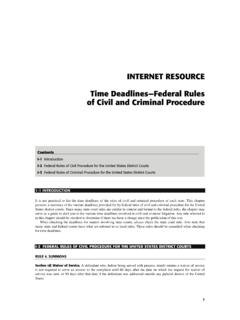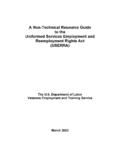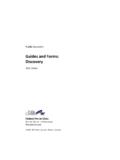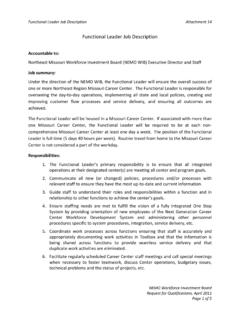Transcription of RCRA FUNDAMENTALS TRAINING COURSE REGION 4
1 RCRA FUNDAMENTALS TRAINING COURSEREGION 4 For more information on EPA TRAINING courses, contact the EPA TRAINING coordinator, Denise Housley at (404) 562-8495. AGENDA RCRA FUNDAMENTALS COURSE EPA REGION 4 DAY 1 8:30 - 8:45 Registration 8:45 9:00 Introductions 9:00 9:15 History of RCRA 9:15 9:30 RCRA Information Sources 9:30 10:15 Identifying Solid Wastes 10:15 - 10:30 Break 10:30 - 11:30 Identifying Solid Wastes (continued) 11:30 12:00 Hazardous Waste Exclusion 12:00 - 1:00 Lunch 1:00 - 2:00 Characteristic Hazardous Waste 2:00 - 2:30 Listed Hazardous Waste 2:30 - 2:45 Break 2:45 - 3:15 Mixture Rule/ Contained-In Interpretation 3:00 - 3:15 Derived From Rule 3:15 - 3:45 Radioactive Mixed Wastes 3:45 4:15 Problem Wastes 4:15 4:45 Case Studies/Question & Answers AGENDA RCRA FUNDAMENTALS COURSE EPA REGION 4 DAY 2 8:30 - 9:00 Spills and Spill Residues 9:00 9:30 Universal Wastes 9:30 10:00 Treating Wastes without a Permit 10:00 - 10:30 Hazardous Waste Tanks 10:30 - 10:45 Break 10:45 11:30 Recycling 11:30 12.
2 00 Used Oil Management 12:00 - 1:00 Lunch 1:00 2:30 Corrective Action Under HSWA 2:30 - 2:45 Break 2:45 3:45 Land Disposal Restrictions 3:45 - 4:15 Universal Treatment Standards and Underlying Hazardous Constituents 4:15 - 5:00 Case Studies/Question & Answers AGENDA RCRA FUNDAMENTALS COURSE EPA REGION 4 DAY 3 8:30 - 9:00 Review 9:00 -9:30 Rules for Applying Characteristic Codes to Listed Wastes 9:30 10:00 Rules for Determining if Dilution is Allowable 10:0 - 10:15 Break 10:15 - 11:00 Management of Remediation Waste 11:00 - 11:45 Contaminated Soil and Hazardous Debris 11:45 12:00 Question/Answer/Case Studies 12:00 - 1:00 Lunch 1:00 - 2:30 RCRA Organic Air Emissions Standards 2:30 - 3:30 Case Studies 3:30 -4:00 Wrap-up/Question & Answers 1 RCRA FUNDAMENTALS TrainingDay 1 EPA REGION 4 History of RCRA2 Solid Waste Disposal Act of 1965 Technical assistance to states and localities General criteria for designing landfills No authorities to regulate hazardous waste23 Resource Conservation and Recovery Act 1976 Completely replaced Solid Waste Disposal Act (SWDA) Established criteria for sanitary landfills Authorized a regulatory program for hazardous waste including inspection and enforcement authorities Provided mechanisms for: Citizen suits Restraining orders for imminent hazards Research and developmentRCRA 1004(27)4 Resource Conservation and Recovery Act 1976 (cont d) To achieve the goals of RCRA, these programs were developed.
3 Subtitle D Subtitle C Subtitle I Subtitle D addresses non-hazardous waste by encouraging (mandates) states to develop management plans for solid waste45 FR 330935 Resource Conservation and Recovery Act 1976 (cont d) Subtitle C Establishes a regulatory program to identify hazardous waste and to track from cradle to grave Called for the development of technical standards for the design and safe operations of TSD facilities Subtitle I Relates to underground storage tanks Storing hazardous materials Establishes performance standards for new tanks Corrective action program45 FR 3309336 May 1980: Major RCRA Components Promulgated Definition of hazardous waste Rules for generators and transporters Limited roles for existing hazardous waste facilities Initial standards for permitting hazardous waste facilities Permit processing , 262, 263, 2707 Major Omissions Standards for existing (interim status) facilities and for permitting facilities contained: No groundwater monitoring regulations Minimal land disposal regulations8 Additional Significant Dates for RCRA 1981 - Land disposal facility regulations Single liner Many variances 1982 - Groundwater monitoring regulations Significant technical challenge with minimal Agency interaction 1981 to 1983 - Significant Congressional concern with RCRA and CERCLA program implementationRCRA 3004(u)49 Hazardous and Solid Waste Amendments of 1984 Strong vote against land disposal Minimum technology requirements (MTR) Land disposal restrictions (land ban) Corrective action at RCRA facilities Waste minimization Permit deadlines federal facilities requirementsRCRA 3004(u)10 Land Disposal Restrictions (LDR) EPA required to.
4 Evaluate all listed/characteristic wastes Determine which wastes can be placed in the landfill environment as is Determine what wastes can be landfilled after pretreatment26811 Waste MinimizationGenerator must design and implement aprogram to reduce the volume or quantityand toxicity of hazardous wastegenerated on-siteRCRA 3005(c)(3)512 RCRA Statutory Authorities Section 3007 HSWA 3004 u and v permits Omnibus Provision Section 3008(h) Consent Orders Section 3008(a) Orders ("Compliance Orders") Section 7003 Orders Section 3013 Orders Section 9006 Orders13 RCRA Section 3007 Provides EPA authority to enter hazardous waste facilities at reasonable times to conduct inspections to determine compliance Allows EPA to collect samples to determine compliance Allows EPA to request information to support rulemaking or determine compliance Not limited to Subtitle C facilities14 HSWA Section 3004 (u) and (v) Section 3004(u) requires that all RCRA permits address corrective action for releases of hazardous waste or hazardous constituents from solid waste management units (SWMUs).
5 Section 3004(v) requires facility owners/operators to take corrective action beyond the facility boundary. 615 Omnibus Provision 3005 (c)(3) allows permit writer to establish any permit terms or conditions that are necessary to protect human health and the (b)(2)16 RCRA Section 3008(h) Provides authority to require corrective action at: Interim status facilities; Facilities who have terminated interim status; Facilities that have lost interim status; or Facilities that treat, store, or dispose of hazardous waste but have not obtained interim status because they did not fully comply with section 3010 notification requirements or submit a timely Part Section 3008(a) Used to require any person that is not in compliance with the requirements of RCRA to take steps immediately or within a stated time period to return to compliance Used to revoke permit or interim status Penalties up to $32,500 per day may be assessed718 RCRA Section 7003 Orders Used when there is evidence that the past or present handling, storage, treatment, transportation or disposal of hazardous or nonhazardous waste may present an "imminent and substantial endangerment to health or the environment Can be used to require entity to cease and desist or require cleanup19 RCRA Section 3013 Orders Used to evaluate the nature and extent of a problem or potential problem through monitoring, testing.
6 And analysis when it is found that site may present a substantial hazard to human health or the 9006 Orders Requires immediate compliance with UST regulations Can establish a specific compliance schedule May assess penalties for non-compliance8 RCRA Information Sources22 RCRA Information Sources RCRA Online EPA website OSWER Directives federal Register Notices RCRA Orientation Manual RCRA TRAINING Modules National Enforcement TRAINING Institute (NETI)23 RCRA Information Sources Environmental Response TRAINING Program Virtual University (ERTP VU) Trainex Regional Guidance and Tools on Subparts AA/BB/CC and Subpart X924 Internet Sites EPA EPA Office of Solid RCRA EPA Office of Enforcement Compliance and Assistance (OECA) Sites Enforcement and Compliance Document and Information Center (ECDIC) National Service Center for Environmental Publications (NSCEP) Environmental Response TRAINING Program Virtual University (ERTP VU) Sites OSWER TRAINING Forum (Trainex) National Enforcement TRAINING Government Printing Office (GPO) Solid Wastes28 Solid WasteDiscarded MaterialHazardous WasteUniverse of Solid Wastes29 Definition of a Solid Waste RCRA 1004 (27) states: The term solid waste means any garbage, refuse, sludge from a waste treatment plant, water supply treatment plant, or air pollution control facility and other discarded material, including solid, liquid, semisolid, or contained gaseous material.
7 1130 Discarded Material A material is a solid waste if it is (a)(1)31 Discarded Material (cont d) Garbage, refuse, or sludge Thrown away, abandoned or destroyed Spent materials Incidental (a)(2)32 Discarded Material (cont d) Also includes materials that are being stored rather than discarded Old or unusable products Materials which can no longer be recycled or (b)(3)1233 Categories of Solid Waste Abandoned Inherently waste-like Certain recycled materials Military munitions identified in 40 CFR (a)(2)(i)34 Abandoned Disposed of Burned or incinerated Accumulated, stored, or treated before, or instead of, being disposed, burned, or (b)35 Inherently Waste-like Wastes specifically listed F020 F021 F022 F023 F026 (d)1336 Inherently Waste-like (cont d) Secondary materials fed to a halogen acid furnace that exhibit a characteristic of, or are listed as, a hazardous waste Other materials may be determined by EPA to be inherently (d)37 Recycled Materials Specified types of recycled materials are considered discarded Used in a manner constituting disposal Burned for energy recovery Reclaimed Accumulated (c)38 Recycled Materials (cont d) A material is considered discarded if it is accumulated, stored, or treated before (c)1439 Recycled Materials (cont d) A hazardous secondary material is not discarded, if.
8 Generated and reclaimed under the control of the generator Not accumulated speculatively Handled only in non land-based units Generated and reclaimed within the US and its territories Not subject to material-specific management practices when reclaimed It is not a spent lead acid battery and does not meet the listing description for K171 or K172 It is legitimately (a)(2)(ii)40In general, determination of whether a recycled material is a solid waste depends upon the NATURE of the material and the MANNER in which it is (c)41 Nature of Recycled Materials For purposes of determining if a recycled material is a solid waste when recycled, five classes of materials are considered Spent materials Sludges By-products Commercial chemical products Scrap (c)1542 Spent Material Any material that has been used and, as a result of contamination, can no longer serve its intended purpose without reprocessing Spent solvents Spent catalysts Spent pickle liquor Spent plating bath (c)(1)43 Sludge Residues from pollution control devices Wastewater treatment plant sludges Electric arc furnace dust (K061) Baghouse dusts Spent carbon from the treatment of wastewater or air streams Oil from an oil/water separator Ion-exchange and 261(c)(2)44By-Products Process residues that are not one of the primary products of a production process Distillation column bottoms Heavy ends (c)(3)1645By-Products (cont d) By-products should not be confused with co-products A co-product is intentionally produced by the manufacturing process and is ordinarily used in its existing state as a commodity in trade by the general public Co-products must have a recognized use, and must be usable without (c)(3)
9 46 Commercial Chemical Products Compounds listed in 40 CFR P-listed wastes U-listed Metal Metal pieces and parts which, when worn or superfluous, can be recycled Examples: Scrap automobiles Machine shop turnings Radiators Railroad box (c)(6)1748 Manner of Recycling Four methods of recycling are to be considered in determining if a recycled material is a solid waste Use in a manner constituting disposal Use as a fuel or burning for energy recovery Reclamation Speculative (c)49 Use Constituting Disposal The material is applied to or placed on land The material is contained in a product applied to the land (except for commercial chemical products that are normally placed on the land, such as fertilizers) (c)(1)50 Burned for Energy Recovery/Used as a Fuel The material is burned for energy recovery in a boiler or industrial furnace The material is used to produce a fuel The material is contained in a (c)(2)1851 Reclamation Processing to recover a usable product (c)(4) and (c)(3)
10 52 Speculative Accumulation Speculative accumulation is defined as the accumulation of waste materials prior to recycling without sufficient amounts being recycled Sufficient amount is defined as at least 75% during a calendar year EPA may grant a variance on a case-by-case basis for materials that are accumulated speculatively (40 CFR ) (c)(8) and (c)(4)53 = Material is considered a solid waste Use Constituting Disposal [ (c)(1)] Energy Recovery/ Fuel [ (c)(2)] Reclamation [ (c)(3)] except for Speculative Accumulation [ (c)(4)] Spent Materials Sludges that are listed hazardous wastes Sludges exhibiting a characteristic of hazardous waste --- By-products that are listed hazardous waste By-products exhibiting a characteristic of hazardous waste --- Commercial chemical products listed in 40 CFR --- --- Scrap Metal 1954 Military Munitions Unused or defective munitions are solid wastes if abandoned or treated prior to disposal, rendered unusable or declared a waste Used munitions may be a solid waste if collected for storage, treatment, recycling, or disposal62 FR 6621, Diagram- Is it a Solid Waste?









